Biokovo Hiking Trails Undergoing Renovation as Part of Wider Project
September the 15th, 2022 - The Biokovo hiking trails, as well as rest points such as benches, are undergoing a revamp as part of a wider project which will also involve visitor content.
As Morski writes, in Biokovo's gorgeous Kotisina botanical garden, work on the redoing and rearrangement of existing Biokovo hiking trails and benches as part of the wider "Endemic Pathway-ePATH" project has begun.
The mighty Biokovo mountain range is visited very frequently by tourists from all over the world, and the recently installed Biokovo Sky Walk has only boosted their numbers.
These planned works on the Biokovo hiking trails and more are to ensure the safety and renovation of the existing trails and accompanying visitor content such as benches, rest stops, places scheduled for educational activities and so on. As part of the project, the renovation of the drywall, which is a recognisable symbol of Dalmatia, has also been planned. The walls have lost their load-bearing capacity, and their upcoming renovation will ensure this part of local and wider Medterranean heritage is properly preserved for years to come..
The ePATH Biokovo project also envisages the installation of two wooden bridges across the Proslap stream.
The dynamics of the works are also being adapted to the main summer tourist season and the smooth movement of tourists who are visiting the Kotisina botanical garden at this time of year. The scheduled duration of the works stands at ninety days.
The ePATH project was otherwise approved within the Interreg IPA programme of cross-border cooperation between Croatia, Bosnia and Herzegovina and Montenegro for the period between 2014 and 2020. It is being implemented with the aim of strengthening and diversifying the overall tourist offer through cross-border cooperation and the improvement of management and sustainable use of cultural and natural heritage in the area.
For more, make sure to check out our dedicated lifestyle section.
Fancy a Cool Drink? Early Tourism and the Ice Caves of Biokovo
June 19, 2022 - Before household appliances became a thing, keeping drinks cold used to be a much more complicated endeavour. Meet the ice caves of Biokovo.
Located in Dalmatia between the rivers of Cetina and Neretva, Biokovo is the second-highest mountain range in Croatia. It's a natural border between the coast and the Inland Dalmatia, and close to 200 m2 of its area is protected as a Nature Park.
The majestic range is sometimes described as the mountain that has 'its roots in the sea and a head crowned with lightning'. Its peak, St. Jura (St. George) stands at an elevation of 1762 metres, providing a spectacular view of the Adriatic Sea and Italy in the distance, inland Dalmatia, and mountains of Bosnia and Herzegovina. Biokovo is home to more than 1.500 species of flora and fauna; it houses 87 churches and chapels built at various moments in history. Apart from all the wonders proudly showing their faces in plain sight, the mountain keeps treasures hidden away: more than 400 caves.
Here's a question for you: have you ever thought about where the ice in your drink comes from? Probably not, as today the process isn't really that complex; someone poured some water in an ice cube tray, slipped it into a freezer, forgot about it for a couple of hours, and voila. Whether your ice was technically made by a waiter in a beach bar or bought in those massive bags of ice you can find at gas stations and in supermarkets, it's not really that big of a deal –as long as there's enough of it available.

Okay, how about we rewind the timeline a couple of decades? Fridges and freezers that are now standard household appliances have only been in use since the 1940s, and speaking of these parts, you might probably slap a few extra years on top of that. As you might have heard, organised tourism in Croatia has been happily trotting along for almost a century before our coast experienced the luxury of refrigerated goods. We might get heat waves these days, but at least we can run into a room equipped with AC and a mini fridge. What about heat waves in 1910? 1925? How did the poor tourists cool down?
That's where Biokovo comes in. Some of those 400 caves used to be (and still are) filled with eternal, ever-present ice. The locals who resided in various parts of the mountain range thought of a way to add to their budget in hard times: they harvested ice from the caves and transported icy blocks all the way to Makarska riviera, where the first hotels in operation used the priceless goods to refrigerate food and, supposedly, serve it in drinks. The icicles were first wrapped in beech leaves and sack cloth so they wouldn't melt too quickly, then loaded onto donkeys and mules. A whole process, one that entailed a long, wearying overnight journey from the caves to the coast in order for the ice to arrive on time, in good condition.

It's hard to guess if the guests wondered about the origin of their cold beverages. Imagine a random tourist in the first half of the 20th century asking where the ice comes from – what could the waiter even say? Underground? From the core of that mountain you can see in the distance? Or maybe... You wouldn't believe me if I told you.
Read more about Biokovo here. While you're at it, we have a great series about the National Parks of Croatia going on; learn more about the Kornati islands and the Brijuni islands.
Split Area Caves and Pits Turning into Landfills (PHOTOS)
August 29, 2021 - Volunteer speleological initiative "Čisto podzemlje" (Clean Underground) is on a mission to raise awareness about the increasing number of Split area caves and pits that are becoming active landfills.
The volunteer speleological initiative "Čisto podzemlje" (Clean Underground) is tirelessly fighting against throwing waste into the karst underground, and the increasing number of negligent scenes throughout Croatia has not discouraged them on their mission, reports Slobodna Dalmacija.
The association members shocked their Facebook followers after sharing photos of the huge landfill they found in Gaćina jama in the Biokovo hinterland, where waste from the densely populated area of Zagvozd ends up.
"Let's wake up after the summer break. Cave reports about new underground atrocities are arriving ... We start with the Gaća pit in the hinterland of Biokovo near Zagvozd. It is one of over 103 contaminated sites in the vicinity of Split (only a few have been cleaned).
The garbage in the pit is completely fresh ... dumped from a nearby road yesterday. Local people injected over 100 cubic meters of household waste, carrion, bulky and construction waste, medicines, chemicals, and pesticides. So far, only we speleologists have seen the garbage, because the surroundings of the entrance are as clean as a tear, and in the underground a horror movie. Thank you, Osmica Karlovac, for reporting!"
"30 years of flattery and pain have come to fruition," "We haven't learned anything, nor will we," "So what are uncivilized people doing to us?" "You will poison us all," the comments below the post follow.
"We devastate everything we touch and, what’s craziest, we think we have a right to it," another remarked.
"It is important that the biggest problem in Split is the new beach for dogs, because they will dirty the sea," someone else protested.
The bottom of Gaćina jama has a diameter of 20 m, and as of this weekend, it is covered with more than a hundred cubic meters of waste. However, it remains unknown whether it extends further into the depths.
"There is carrion, large and small municipal waste, construction and hazardous waste, drugs, chemicals, pesticides," it is stated on the association's website.
Speleologist Ruđer Novak of the "Clean Underground" initiative says that over 900 similar locations have been detected in Croatia so far, but he notes that this is certainly not all.
The initiative has cleared dozens of underground landfills in recent years. But, unfortunately, it also happens that the cleaned site is very quickly refilled with waste.
"There were cases when we thought that we would clean the pit 'once and for all, because the garbage in it is old, and the nearby village has been displaced. But then it happens that shortly after cleaning it, the weekenders come. In the abandoned villages, of course, there are no containers, so those who visit their grandparents to clean the old house, throw all the waste into the pit," said Novak as one classic example.
"The whole village used the landfill in the hinterland of Biokovo for a long time. This is partly a matter of the population's habit, which did not have organized waste collection until 15 or 20 years ago. It's just that it was once dead sheep, wood and stones, and today plastic, car tires, TVs… So the composition of waste has changed, which is a great environmental threat," said Novak.
The main problem, he points out, is the pollution of water, which seeps through the rubble and breaks through the waste deposits.
"Caves and pits are natural pathways by which surface water seeps into the underground, and it is the water that feeds our springs and makes up our water pumping station. In this case, the water is drained through landfills. This means that everything thrown into the pit eventually ends up in a glass on the table," he warned.
He also notes that 70 percent of all Croatian endemic species are underground animals.
"The area of the Dinaric karst has the greatest diversity of underground fauna in the world; our country is unique in that respect," he said.
Novak adds that people are sometimes unaware of the damage they are doing and stresses the importance of educating people in local communities, to whom no one has so far explained how wastewater ends up in their wells as well.
Speleologists have noticed that the majority of waste in Gaćina jama has been freshly dumped, which means that it is an active landfill.
"It is easy to unload a waste truck into a pit, while cleaning is very demanding," said Novak.
He emphasizes that landfills contain not only plastic and electronic waste but also carrion and mines.
"We are closely cooperating with the Ministry of the Interior's anti-explosion service since explosives were found in the pits not only from the Homeland War but also from the First and Second World Wars. Grenades found underground are full of heavy metals that decompose over decades and thus poison people and the environment," he added.
Since cleaning underground landfills is a demanding and dangerous undertaking, only specially trained people can engage in it. Thus, interested and concerned citizens cannot participate in volunteer actions.
"There are 700 or 800 speleologists in Croatia. They are all volunteers. Only they and HGSS members are trained to clean landfills because they use speleological rescue techniques. Rope systems are used to bring the load to the surface. Civilians, unfortunately, cannot get involved in volunteering because it is physically impossible. So we are constrained in terms of the number of people," the speleologist explained.
Novak notes that cleaning actions are possible thanks to donors, among which the leading retail chain is LIDL. Because of this, the association was allowed to change the model of functioning.
"We try to attract as many donors as possible so that we can continue this story. However, speleologists volunteers do work for which the state is not capable; no company on the market would deal with it," Novak concluded.
For more on lifestyle in Croatia, follow TCN's dedicated page.
Geological Park Biokovo Imotski Lakes In UNESCO Network In Two Years
December 9, 2020 – After Papuk Nature Park and Vis Archipelago, Croatia will soon get another geopark under UNESCO protection. If everything goes according to plan, Geological Park Biokovo Imotski Lakes' proclamation is expected in the next two years.
As Lokalni.hr reports, the National Commission for UNESCO Geoparks of the Republic of Croatia sent the UNESCO Council of World Geoparks based in Paris documentation for registration and accession of the Biokovo-Imotski Lakes Geopark area to the network of UNESCO World Geoparks.
A unique area of Dinaric karst
"This completes a significant chapter on our path to the ultimate goal of becoming a Geopark under UNESCO protection," said Luka Kolovrat, director of the Imotski Tourist Board Imota.
The arrival of UNESCO evaluators is expected in the summer, and if everything goes according to plan, the Biokovo-Imotski Lakes Geopark's proclamation will be in the next two years.
"The initiative was launched in 2018 when we reported the Imotski Lakes Geopark project to the National Commission, and at the same time, the Biokovo Nature Park had a similar initiative. The position of the Commission was to unite the initiatives and to approach this project together," says Kolovrat.
There are many reasons for this. One of them is that the area of Imotski Krajina (Imotski region) with the Biokovo Nature Park is a geologically, geomorphologically, and unique landscape area of the Dinaric karst. Thus a joint application would use the potential of both areas for the benefit of the local community.
"At the end of 2018 and in 2019, the City of Imotski carried out a very complex and comprehensive geological research of the area of Imotski Krajina. It was the basis for future applications. The Geological Institute prepared the geological brochure of Imotski Krajina. At the same time, we conducted intensive negotiations with representatives of PP Biokovo on a joint application, defining names, headquarters, borders, coverage, management of Geopark, etc. At the end of 2019, the geological brochure was presented to the public, and the association Geopark Imotski Lakes was founded, which took over the management, operational affairs, and coordination from the Imotski Tourist Board," Kolovrat states the chronology.
In May this year, they sent a letter of intent to the Ministry of Economy and Sustainable Development. In July, they presented the project, after which they received a letter of support from them.
A piece of the planet of inestimable wealth
The next step is the arrival of UNESCO evaluators in the summer, and until then, they have a lot of work to do.
"In the next period, we need to implement the activities from the management plan: mark about a hundred sites that we have identified as geological, natural, and cultural sites, mark geological trails, do training for agencies, renters, family farms who should become partners of Geopark, create a bilingual website, promotional video, print brochures and various promotional materials," announces Kolovrat.
UNESCO Geoparks are unique geographical areas of international importance governed by a holistic concept of protection, education, and sustainable development.
"The UNESCO brand will lead to the recognition of our area at the global level. The creation of innovative crafts and new jobs encourages new sources of income as part of geotourism, strengthening the local community. At the same time, the geological, natural, and cultural heritage of the area remains protected. We believe that this piece of a planet of inestimable wealth on which we have the privilege to live, and we are its heirs, deserves to become part of the UNESCO family to the pride of us and the generations to come," says Kolovrat.
Geological treasury of Croatia
Due to its geological diversity and numerous fossil finds of organisms from the Pannonian Sea, the Papuk Nature Park was the first Croatian Geopark under UNESCO protection. Papuk is also in a nature park category since 1999, and the first geological natural monument in the Republic of Croatia is located in the Park.
Last year, UNESCO added three European sites to its geological parks, including the Vis Archipelago. In the geological past 220 million years ago, a magmatic breach formed the present islands of Jabuka, Brusnik, Biševo, and Palagruža. Palagruža is also geologically the oldest island in the Adriatic, which, like the island of Brusnik, is continuously growing under the influence of tectonic activity.
For the latest travel info, bookmark our main travel info article, which is updated daily.
Read the Croatian Travel Update in your language - now available in 24 languages
VIDEO: Visitor Easily Unscrews Part of Biokovo Skywalk, 1228 Meters Above Sea Level
September 23, 2020 - Less than 90 days after the Biokovo Skywalk opened, a Makarska Facebook group shared a video by a visitor who too easily was able to unscrew part of the attraction, which stands 1228 meters above sea level.
24 Sata reports that Facebook page Dnevna doza makarskog nereda published a rather troubling video from the recently opened Biokovo Skywalk above Makarska.
"Less than 90 days after the opening of Skywalk, the screws are unscrewing themselves," it is written in the post, while in the video, the visitor can be heard saying: "Here it is, it's easily unscrewing."
The video shows a man unscrewing a screw that holds a part of the Skywalk's protective railing, which stands tall at a height of 1228 meters.
Index.hr has since contacted the Biokovo Nature Park Public Institution, which is in charge of Skywalk.
In response to Index's inquiry, they say the contractor was notified when the video went public. They add that no irregularities were noticed.
"The Biokovo Skywalk passed all the necessary safety and durability tests before it was opened for visitors. After the video went public, the contractor was informed about it, as well as expert supervision, and all screws were checked and have been found to be in good condition. The lookout remains open to visitors until the end of the visitor season. We point out that the lookout itself has been visited by more than 100,000 visitors since its opening," the response reads.
The Skywalk Bikovo lookout was opened in early July by Prime Minister Andrej Plenkovic and is part of the 'New Adrion' project worth 31 million kuna, which is mostly financed from the European Regional Development Fund.
It was designed to be in the shape of a horseshoe that towers over a cliff overlooking the Makarska Riviera, the Adriatic, the islands, and the open sea.
The project partners were the Public Institution Makarska, the development agency 'MARA' and HGSS.
At the beginning of the year, a video was shared by Dalmatinski Portal, in which people jump over a fence to visit the still unfinished Skywalk.
At that time, they had not even installed the supports for the protective railing.
The construction of the lookout is part of a project called 'New Adrion - Promoting the Sustainable Use of the Natural Heritage of PP Biokovo'.
The Skywalk is located 1228 meters above sea level and is envisaged as an upgrade of an existing lookout point in the Ravna Vlaška area of the Biokovo Nature Park.
This lookout is designed as a prestressed reinforced concrete structure that cantilevers over a cliff overlooking the Makarska Riviera, Adriatic, islands, and open sea. A glass walkway has been laid on the primary concrete structure to provide a bird's eye view in all directions, creating a unique adrenaline experience.
The potential of the Ravna Vlaška lookout point has been enhanced by an innovative architectural and engineering solution, which with its attractiveness, goes beyond the local tourist offer and contributes to the tourist potential of the whole of Dalmatia.
Within this part of the Biokovo Skywalk project, which will be in the zone of the visitor infrastructure of Ravna Vlaška, the construction of a geological pillar with special info blocks is envisaged.
The total cost of the construction of the lookout and the geological pillar, as well as its accompanying surveillance, stands at slightly more than 8 million kuna in total.
For the latest travel info, bookmark our main travel info article, which is updated daily.
Read the Croatian Travel Update in your language - now available in 24 languages
A Day Trip to Biokovo, A Beautiful Nature Escape Above Makarska
September 16, 2020 - Besides the newly opened Skywalk, Biokovo Nature Park offers several reasons worth visiting. This second-highest mountain in Croatia is a paradise for all lovers of nature, sports, or simply the beautiful views that extend from its heights. If you are looking for a destination for a city break, consider a day trip to Biokovo!
Biokovo is a mountain range that separates the Adriatic from Zagora, and if you are lucky, you can see Italian Monte Gargano in nice weather. Inhabited even before the appearance of the letter, Biokovo was named after the snow whiteness, as evidenced by the fact that it is closed to visitors from mid-November until early April.
A narrow and steep mountain road leads to the top of Biokovo at 1762 m, Saint Jure, which is certainly a great challenge, not only for driving a car but also for cyclists and alpinists.
Nature
I think there is not much to talk about the natural diversity of Biokovo. It is enough to know that it is inhabited by seven different species of amphibians and about 20 species of reptiles. In addition to numerous endemic delights, the park is also home to the spotted Ratsnake, one of the most beautiful European snakes.
Given that due to the inaccessible terrain and often unfavorable climatic conditions, the fauna is still insufficiently explored, most will encounter only horses and donkeys, which you can see while grazing grass along the road.
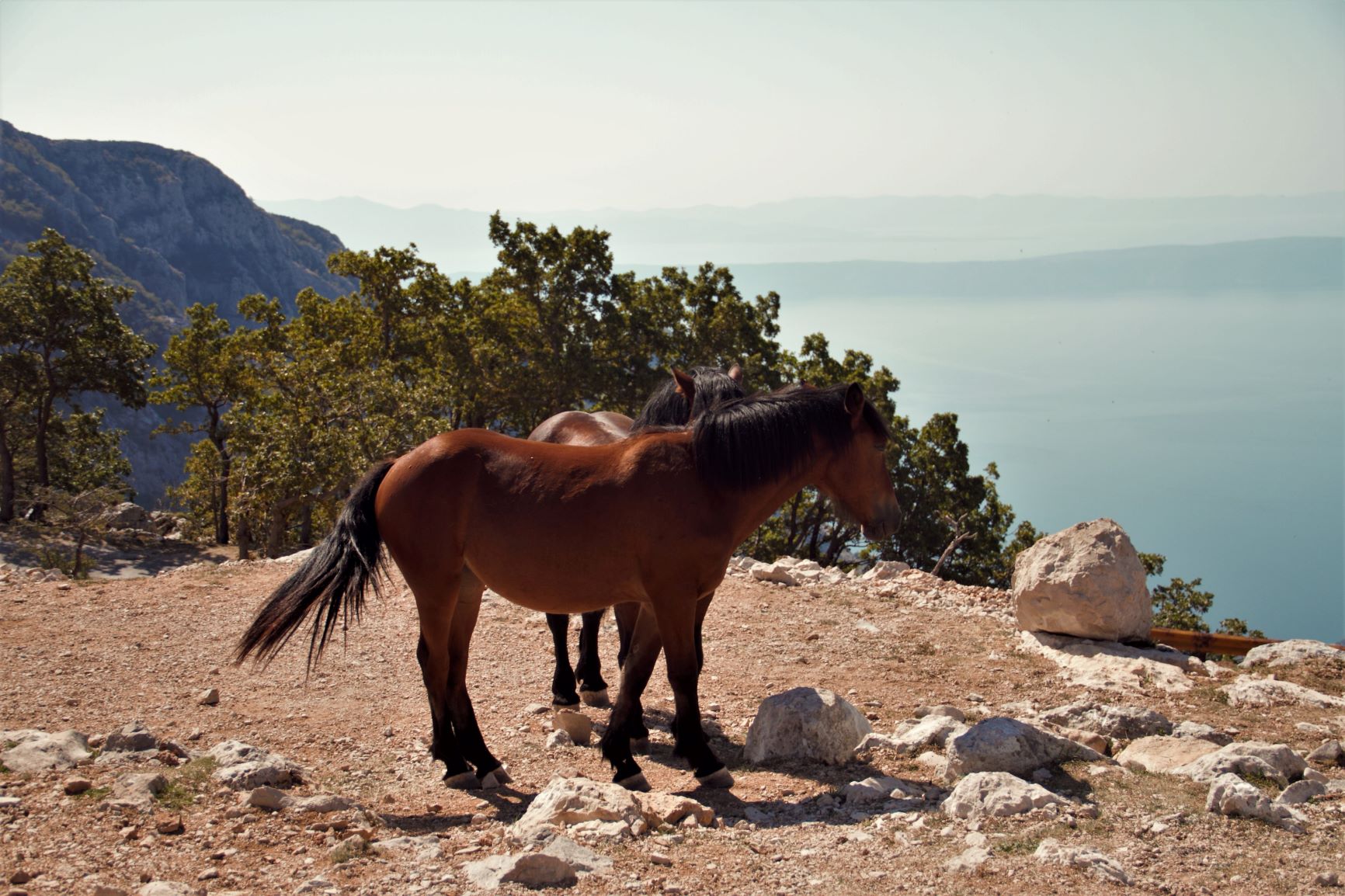

Saint Jure
If you were on Biokovo and you didn’t go to the top, it is like you weren’t even there. On the south side, there is a beautiful view of the Makarska and Dalmatian islands and on the north side of Imotski and Bosnia and Herzegovina.
Apart from breathtaking views, there is also a picturesque church of St. Jure, built-in 1968, not far from the old church demolished due to the construction of the transmitter. However, this is not the only church on the mountain. Except for the most famous one, there are 87 other churches and chapels.

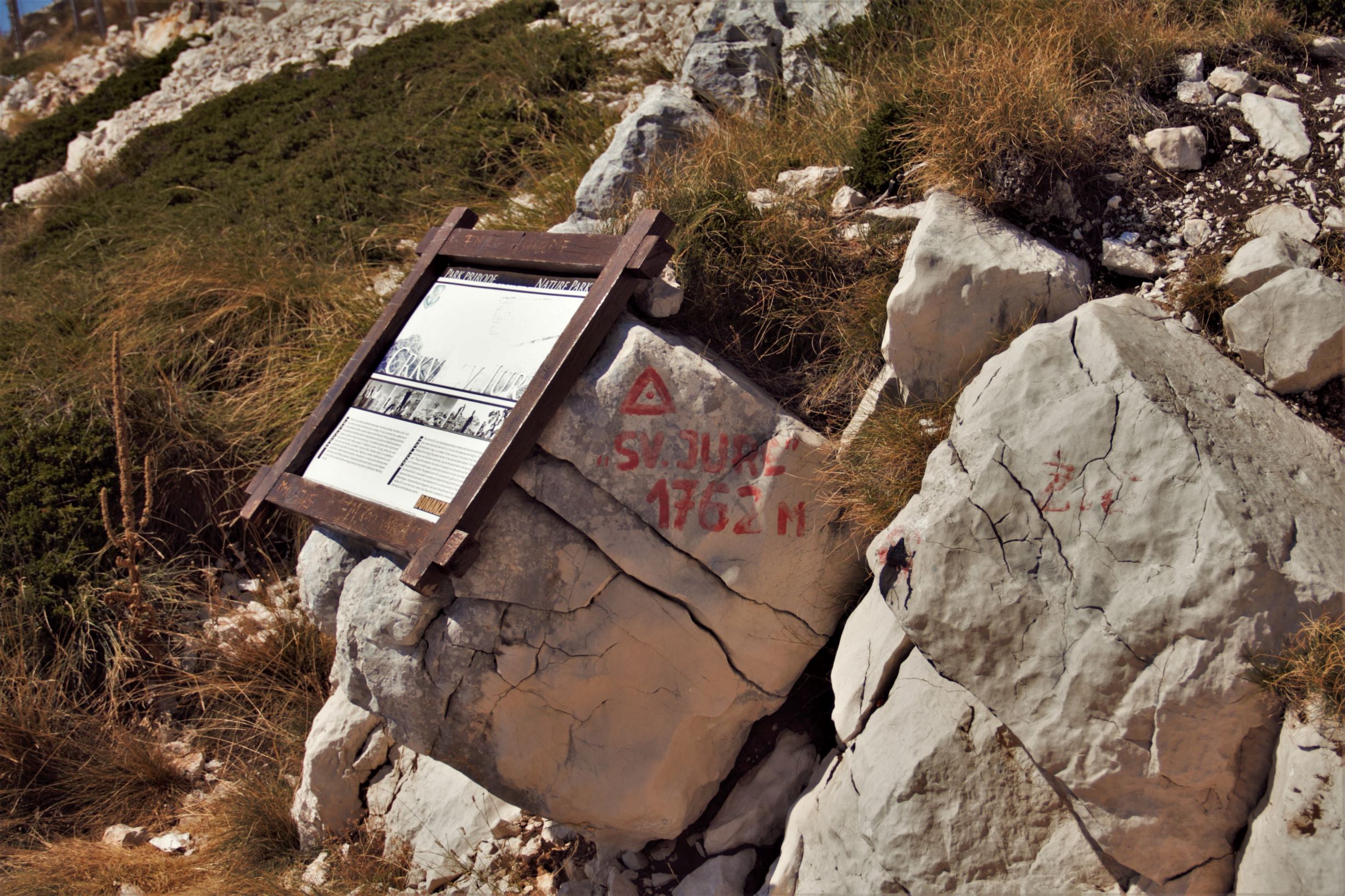

Cycling and hiking
For fans of recreational sports, such as cycling and hiking, going to Biokovo can be an active vacation, a combination of recreation and enjoyment. The oldest hiking trail to climb to the top of Sveti Jure, on the south side, leads from the village of Makar, passing the mountain lodge Vošac and the mountain lodge under Saint Jure. The trail meanders continuously, shortening the serpentines, and the higher it climbs, the narrower the trail and the shorter the serpentines.
If you are adventurous, this could be a real challenge for you!
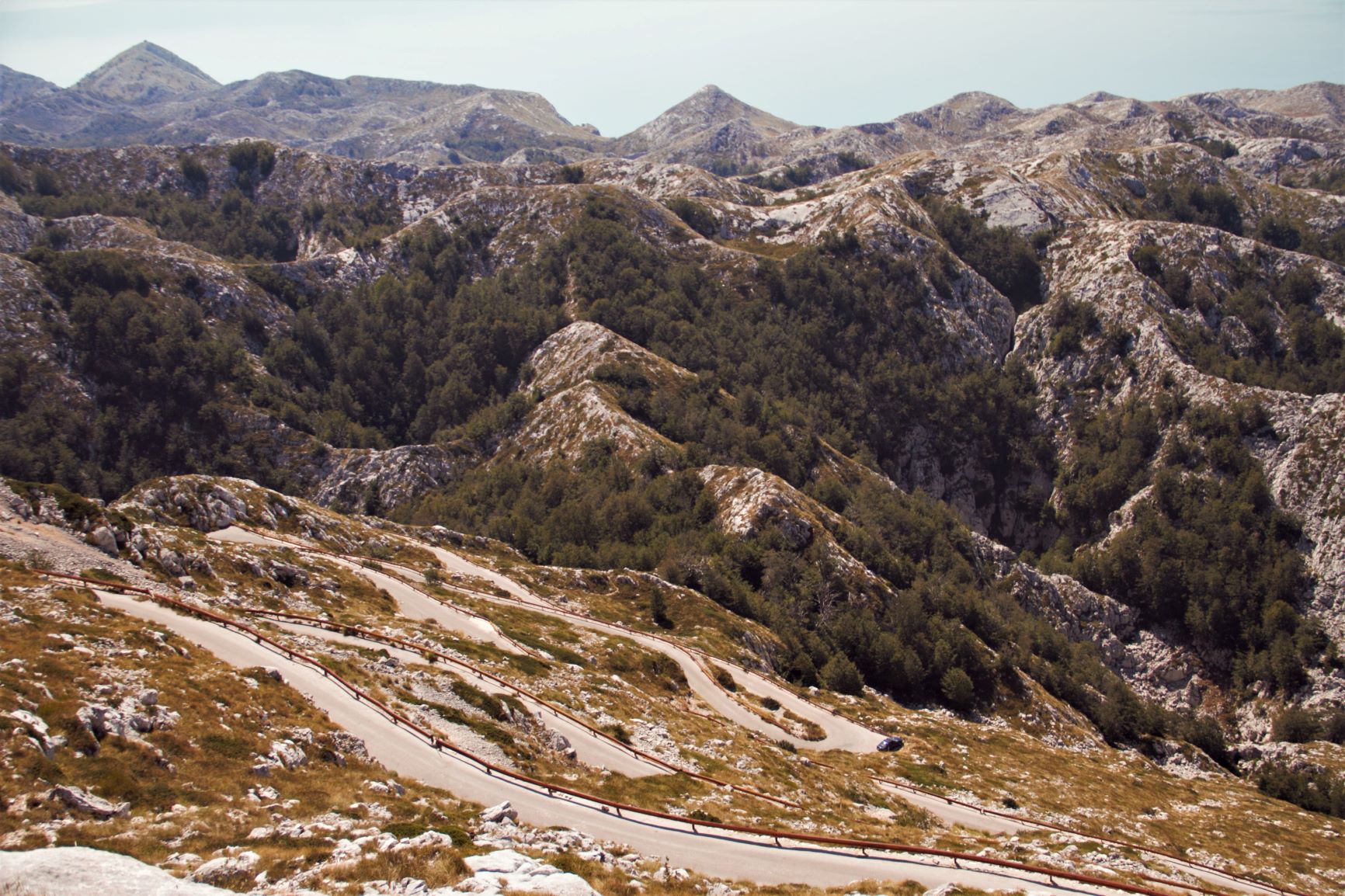
Domestic food
In the nature park, at 900 meters above sea level, in the heart of Biokovo is located a house of rural tourism, the Doors of Biokovo. You can try excellent food prepared the Dalmatian way, such as homemade prosciutto and cheese, grilled specialties, homemade 'peka,' and the like. You can also try homemade herb-brandy, known as 'travarica,' made from 48 herbs, widely known worldwide. For those who are not lovers of alcohol, there are a variety of teas.
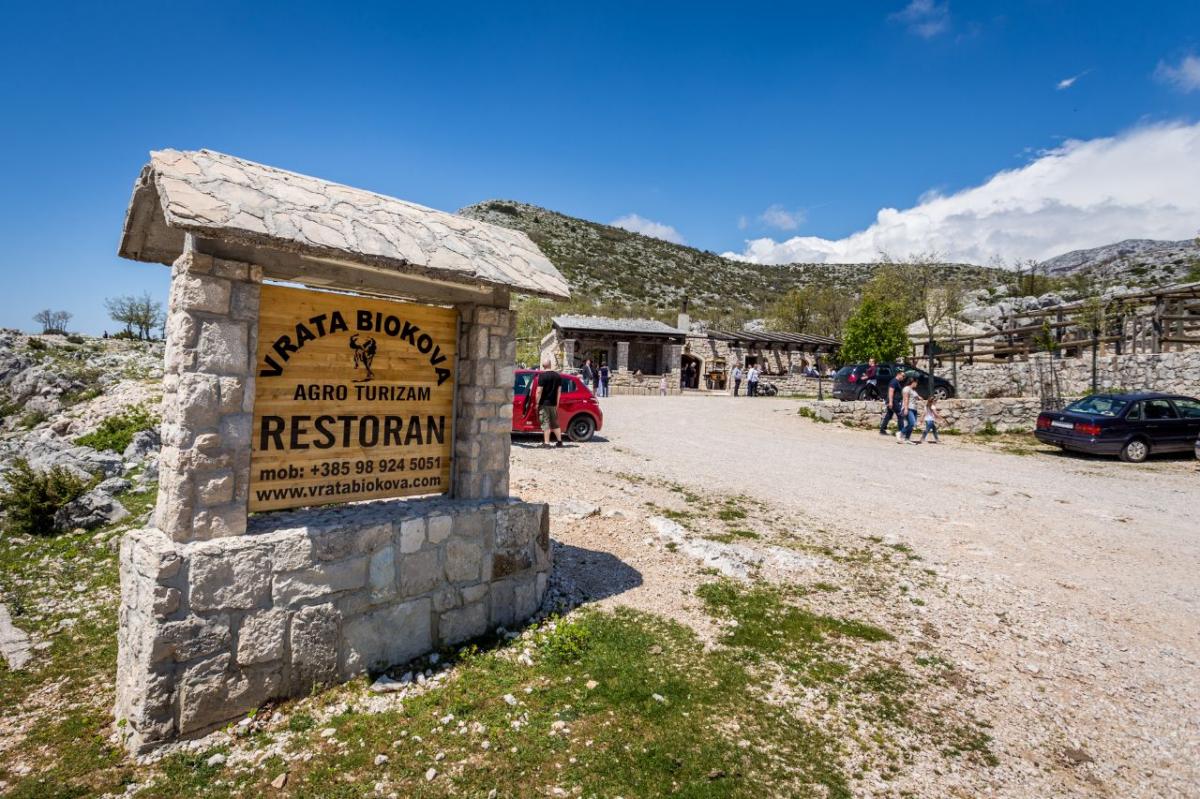

Skywalk
After opening in early July, Skywalk attracts many visitors, both domestic and foreign. You can hear exclamations of enthusiasm in various world languages, but few don't dare to take a walk. As part of the lookout, a geological column was built - a three-dimensional view of the cross-section of the rocks that formed the area of Biokovo from its inception until today with a geological table of time and a description of the age and type of rocks.
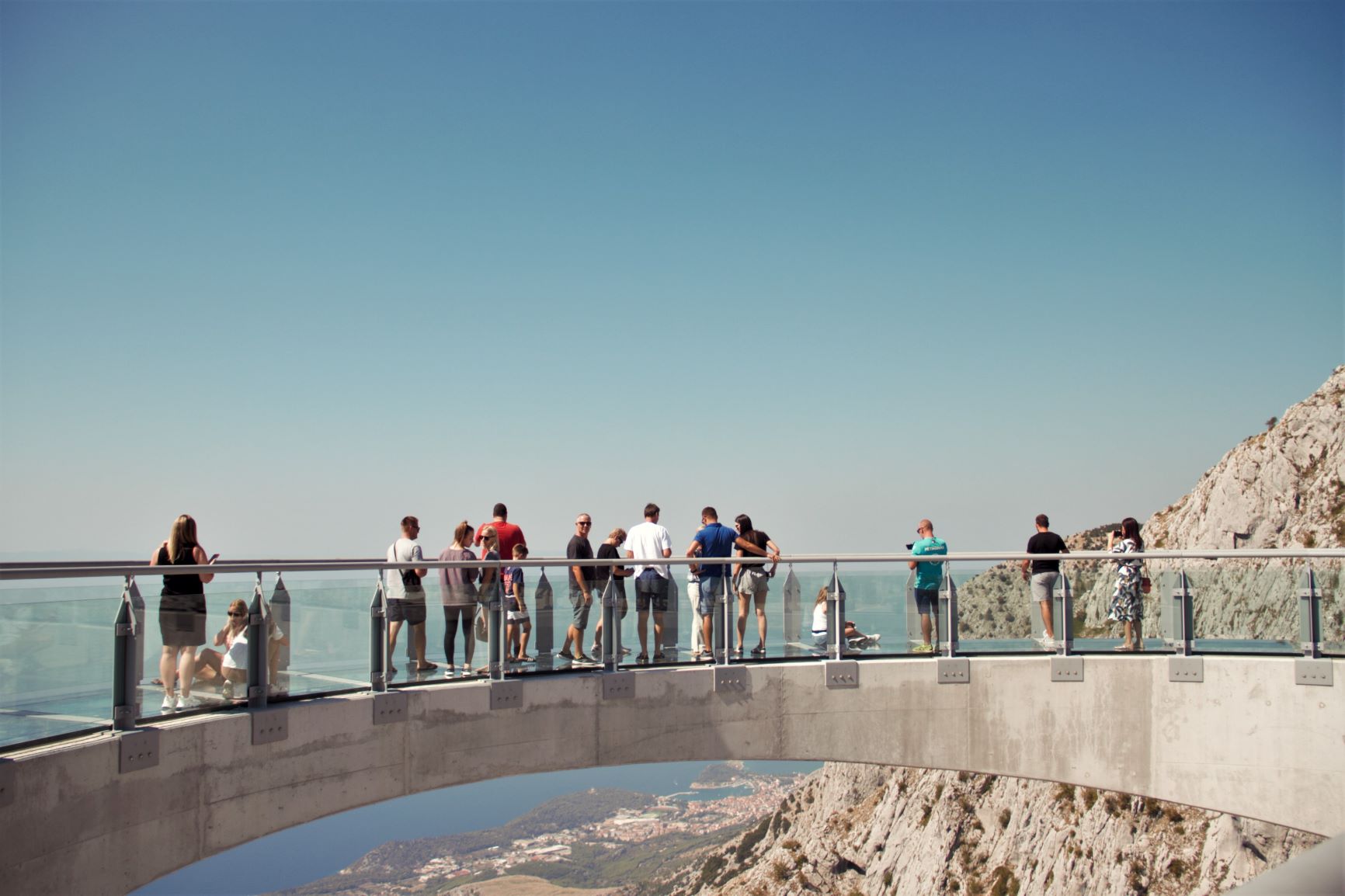
If by now you didn’t know how to spend a September Sunday, here's an idea.
All photos © Sara Alduk
For the latest travel info, bookmark our main travel info article, which is updated daily.
Read the Croatian Travel Update in your language - now available in 24 languages
Join the Total Croatia Travel INFO Viber community.
Polish Ambassador Thanks Croatia For Efforts To Find Missing Hiker
August 22, 2020 – Polish Ambassador Andrzej Edward Jasionowski writes in heartfelt gratitude on behalf of the Polish Republic and its people. Addressed to Interior Minister Davor Božinović, the letter sincerely thanks Croatia, HGSS, the police, army and volunteers for their tireless search.
The Polish Ambassador, Andrzej Edward Jasionowski, has sent an official letter of gratitude to Croatia for the sustained efforts in trying to find a missing hiker. The document was sent to Croatian Interior Minister Davor Božinović but clearly it is addressed to members of HGSS, the Croatian police, army, air force and the country's volunteers who manned the search.
Letter sent by the Polish Ambassador
In the letter, Polish Ambassador Mr Jasionowski details his inability to address individually every member of the vast search party, who scored the mountain range around Biokovo for his missing countryman. In sending the letter to the head of the Ministry for the Interior, he clearly wishes the sincere thanks to be passed on to all those involved in the action.
Polish Ambassador Mr Jasionowski also acknowledges, on behalf of the Polish nation, his awareness of the cost of such an extensive search. 600 people including members from 15 stations of HGSS (the Croatian Mountain Rescue Service) from across Croatia, mountain rescuers from Bosnia and Herzegovina, the Croatian army, the Croatian police, members of mountaineering associations and many volunteers were involved in the search. Croatia allocated €160,000 for helicopter flights and the aerial search alone. Volunteers were assisted on the search by tracking dogs and drones, which took thousands of photos.
39-year-old Polish national Lukasz Dariusz went missing while hiking on Biokovo on Friday 31 July 2020. Unfortunately, he still remains missing.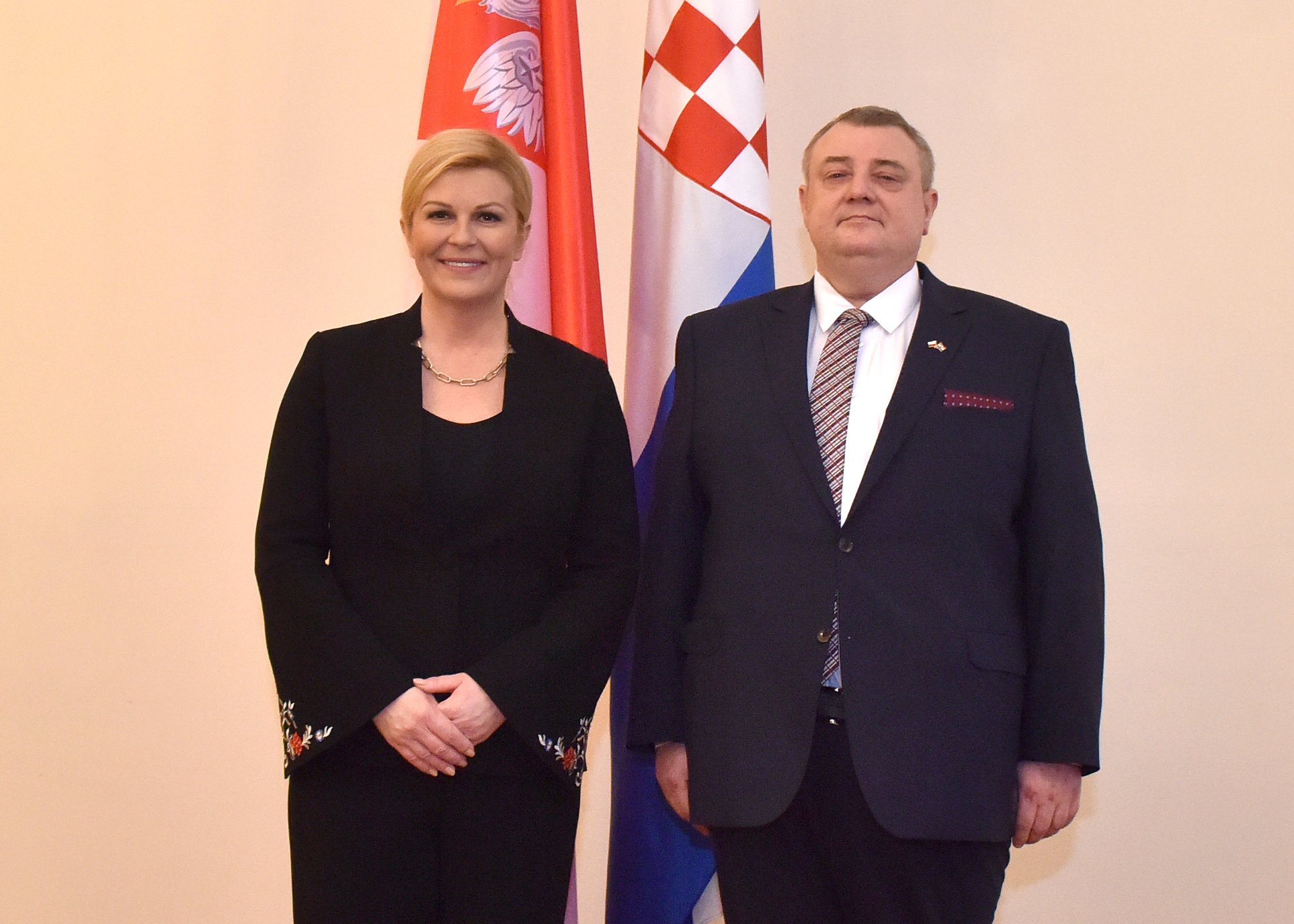
Polish Ambassador to Croatia Mr. Andrzej Edward Jasionowski, pictured with Mrs. Katarina Grabar-Kitarović in 2018 © Polish Embassy Zagreb
Meet HGSS The Croatian Mountain Rescue Service
August 19, 2020 – All weather, all terrain, all year round – meet HGSS The Croatian Mountain Rescue Service, amazing volunteers who will never let you down
They're never far from the news. For the last two weeks, members of HGSS The Croatian Mountain Rescue Service have yet again been on the TV news every night. They're leading the search for a summertime visitor, a Polish hiker missing on Biokovo mountain.
But, watch again this winter and, for sure, they'll be in the headlines once more. Whether, they're scaling mountain ranges in the unbearable heat of high summer, searching underwater caves, flooded rivers or the sea, breaking through wild forest or trudging through metres of snow, they undertake their search and rescue missions over every terrain, in every weather condition, in every month of the year, all across Croatia. And, they all volunteers.
Marc Rowlands meets the head of service for HGSS The Croatian Mountain Rescue Service and three of its volunteers to find out who they are and what makes them do what they do.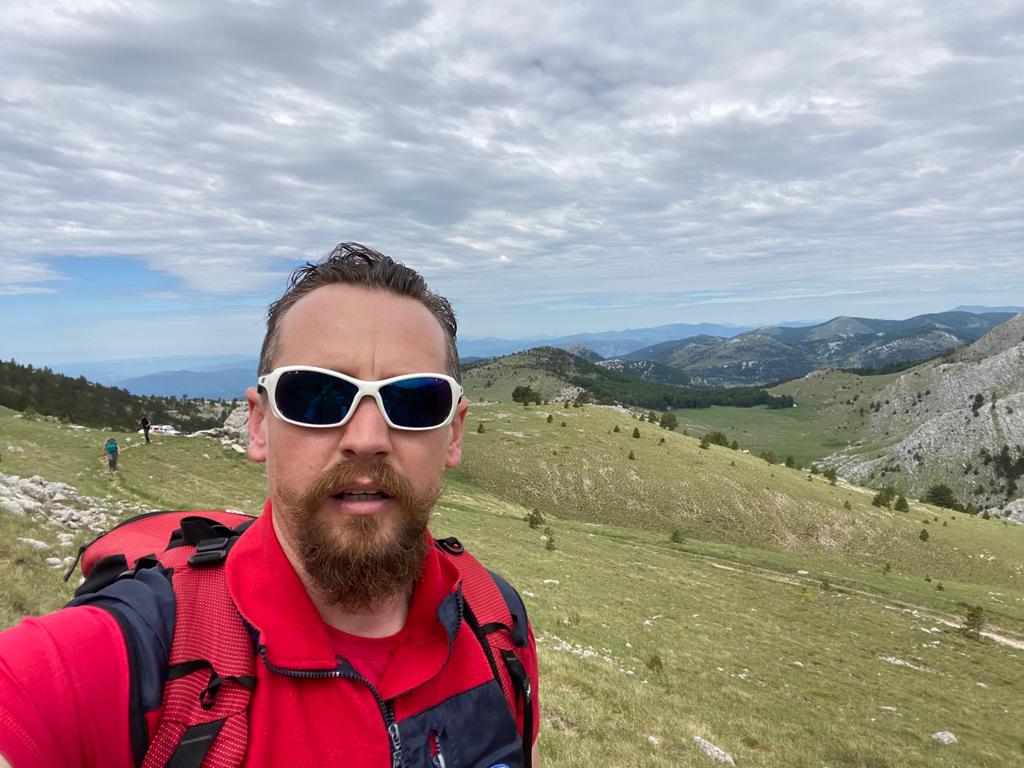
Josip Granić, head of service for HGSS The Croatian Mountain Rescue Service
My name is Josip Granić. I'm the Head Of Service for HGSS The Croatian Mountain Rescue Service. We've had an extremely busy couple of weeks. Being head of service for an organisation like this under such circumstances means you're always on the phone; co-ordinating, talking to outside organisations, members of the press. Communication. It's a 24/7 job, 365 days a year. If people need help, you can't take a holiday. Not at this level of the organisation.
We have around 1000 members. There are 11 paid positions in the main organisation and 25 people we pay to run the administration in each of the teams or stations we have. All of the members who perform the search and rescue are volunteers. We have pilots, surgeons, nurses, students, professors, every part of society.
I'm originally from Kaštela, but my home station is in Karlovac. I've been there for 15 years. I've been Head Of Service for two. Since I assumed the position, I've spent most of my time in the car. I travel all over Croatia.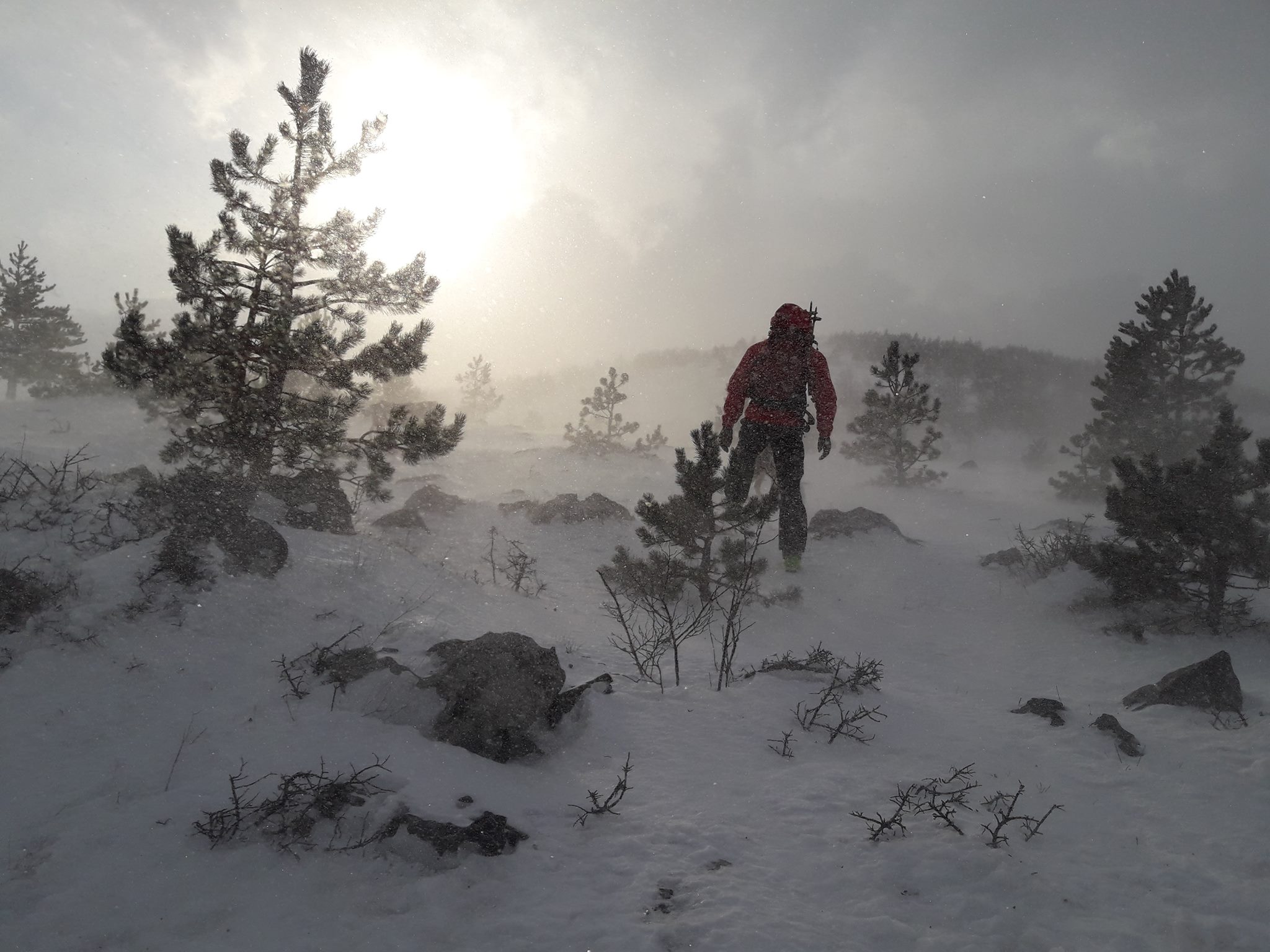
HGSS The Croatian Mountain Rescue Service missions can be hampered by extreme weather conditions © HGSS The Croatian Mountain Rescue Service
To get a certified position as a mountain rescuer in Croatia you all do the same training. It doesn't matter if you come from Slavonia, Dalmatia or Istria, you must have the knowledge and ability to deal with circumstances in any terrain; caves, pits, mountains, on snow, underwater.
Depending on where your station is, the type of call-outs you get could be very different. In Slavonia, 90% are for missing persons - searching forests, rivers, and in floods. We've had a big search on Biokovo mountain for the past 16 days. The stations from Split, Makarska, and Dubrovnik were at first involved, then teams from all over Croatia. It's not the same as Slavonia. The terrain is very different, so you have to be good at a particular set of skills. But, the largest percentage of call-outs is still missing persons. It's 70% of our work nationwide. The other 30% are rescues.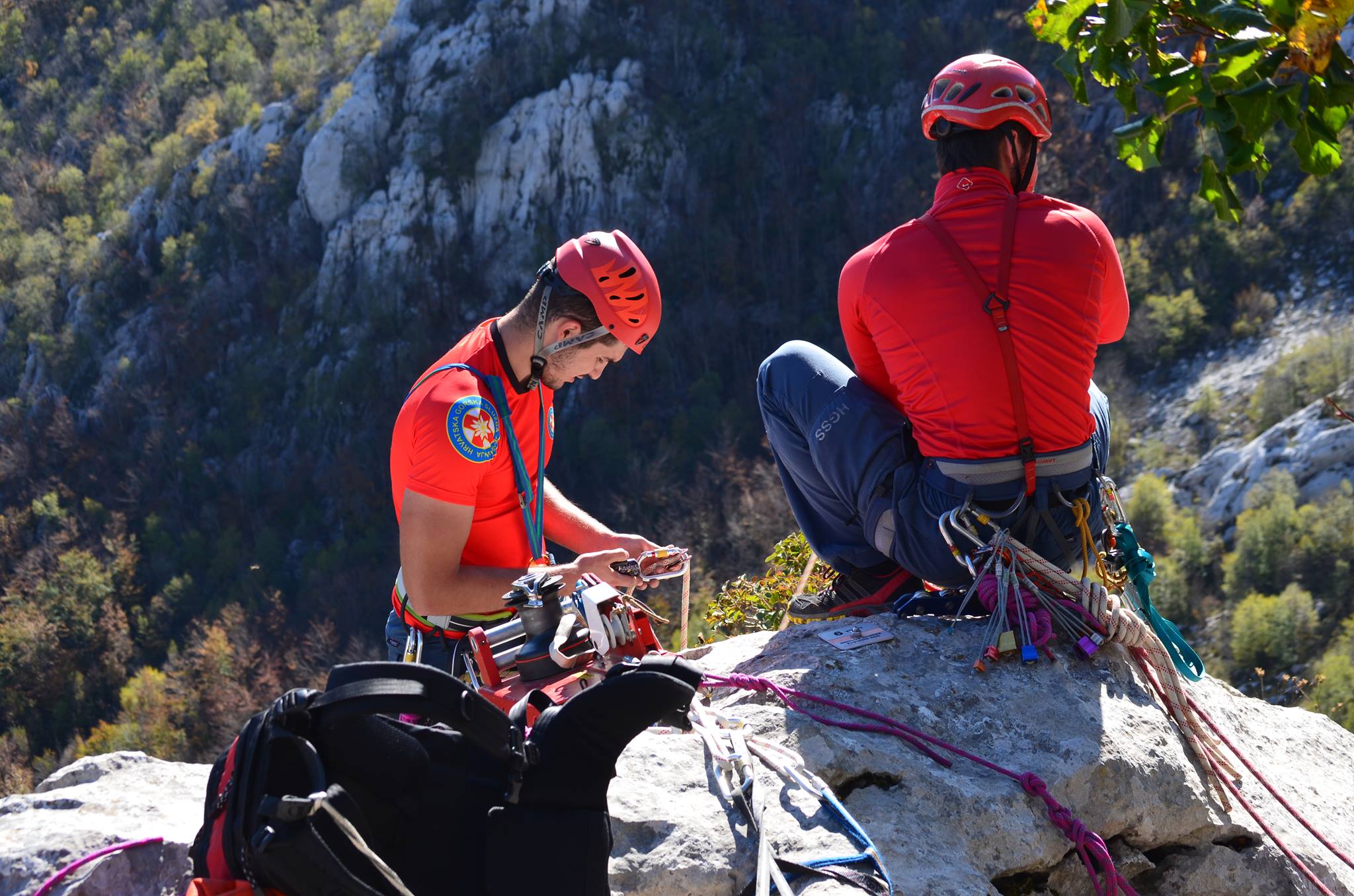
HGSS volunteers are educated to use a wide range of technical equipment. They are trained to operate in all the different kinds of terrain found across Croatia © HGSS The Croatian Mountain Rescue Service
There are usually 800 – 1000 missions a year across the country. We get roughly the same amount of calls in colder months as in warmer months. Only, winter months can be busier. The terrain is more difficult. There are some villages in Croatia – usually where the front line of the fighting was, around Karlovac, Kordun, Lika – and when it snows, it can be almost impossible to reach those places. But, some older people still live there. It can take days to reach them on snowmobiles, then skis, to deliver food or medecine. The other busiest places in winter are the ski resorts - Platak, behind Rijeka, and in Zagreb, on Sljeme. There are teams stationed in those places throughout the snow season.
What's the greatest danger of the job? Almost everything. Nothing in this job is easy. The greatest dangers we face are the same facing those that we rescue - underestimating the environment, nature, the conditions. That's where our training comes in.
In mountain rescue, we separate dangers into subjective, objective and technical. Subjective is the stuff you're guilty of - lack of preparedness, knowledge or equipment. Objective dangers are the ones you can't control, like sudden changes in weather, or avalanche. If you're sensible and informed, there should be no objective danger.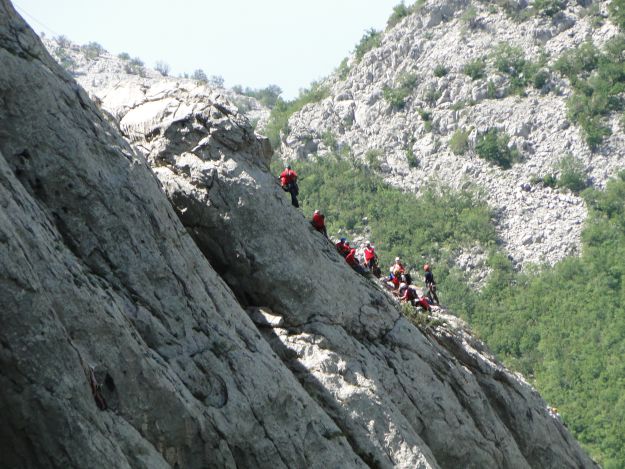
HGSS on a mission, clinging to a steep incline in Paklenica © HGSS The Croatian Mountain Rescue Service "People need to be aware at all times on the mountains. By the time most people think they may be in trouble, they've usually been in trouble for five or ten minutes already" Josip Granić.
80 – 85% of the people we rescue are Croatian. Only 15 – 20% are guests. People from Czech Republic, Slovakia, Poland, (Austria and Slovenia too) tend to enjoy nature more. They like hiking. That's the reason there are typically more rescues for those nationalities than there are for British, Belgian, French, Italian, America, Canadian or Australian guests. I don't remember the specific year, but sometime between 15 and 20 years ago we had a season where 5 or 6 Czech nationals were being searched for or, sadly, turned up dead. The media covered it and ever since there's been this myth that all the people who get into difficulty are Czech.
The question about expensive helicopter rides - why don't you charge the people you rescue - has been here forever. It's like this - if you're a tourist and you have a car accident in Croatia, the fire service, police and an ambulance will come. You won't get charged. We are a tourist country. According to international agreements, we are obliged to make everything safe for residents and guests alike. We are here, just like the fire service and police, to do our part. The Croatian air force is responsible for the helicopter rides and I have to give credit to them - they are crazy good pilots. Amazing. Even if we did charge everyone we saved - and most of the 85% of Croatians we save would struggle to pay - it still wouldn't be anywhere near the money required to run this service.
The Croatian Mountain Rescue Service used specially trained dogs on their searches © HGSS The Croatian Mountain Rescue Service
In 2007, I got a new search dog. It came from the Ogwen Valley Mountain Rescue service in North Wales. We cooperate a lot. We were sent out on a job to look for a three-year-old male child who had gone missing near Požega at the beginning of January, wintertime. His grandma was watching him and they were in a house on the edge of the woods. Early in the morning, he was playing with a dog. It suddenly ran into the forest and the boy chased after him. The grandmother didn't see it happen. I found him using my new dog, just after 8 o'clock the next morning. He'd been alone in the freezing forest for almost 20 hours.
Time is really moving fast on a job like that, because it's a kid and because it's so cold. Survival rates in such conditions are not good after 24 hours. When I found him, saw that he was alive, those big eyes looking up at me, it's a crazy feeling. You can't describe it. You can't compare it. A lot of positive emotions.
Every mission is special. We meet them all with the same level of determination and professionalism. But, it's the ones where you know you've really saved someone that stand out in the memory. Not the broken leg, where you transported someone – sure, that's an excellent job. But, when you know you've saved someone's life, that they definitely wouldn't be here now if it weren't for you, that's what makes it all worthwhile.
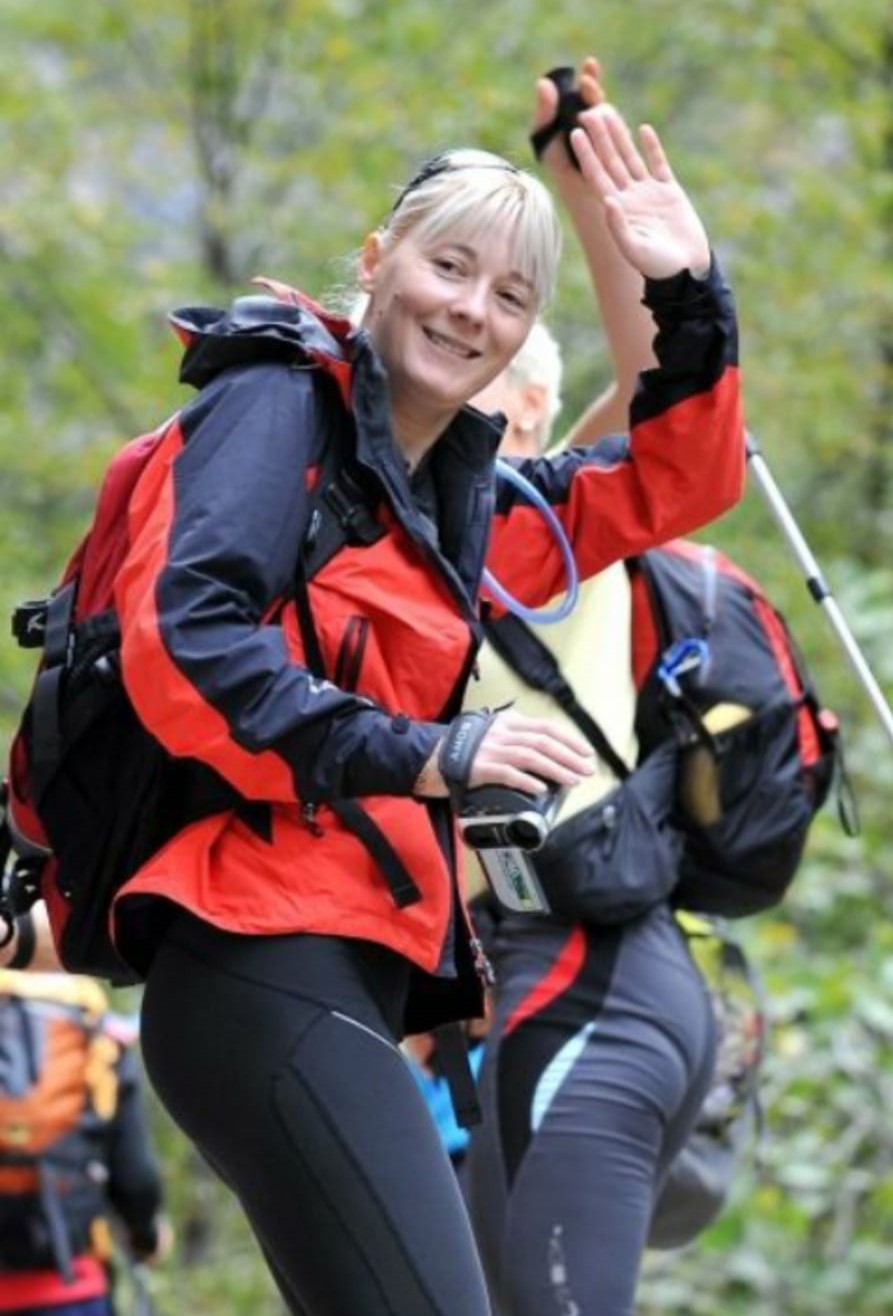
Jana Mijailović, volunteer for HGSS The Croatian Mountain Rescue Service
My name is Jana Mijailović, I'm 48 years old and I'm from Zadar. I finished school to be a teacher, but I never did it. My husband and I run a company that does plastic and aluminium windows for houses.
I started to go into the mountains when I was at high school. I never had the ambition to be part of mountain rescue services – people just noticed me on the mountains. They said I'd be good at it and asked me to join. I met my husband on the mountains. We are both volunteers for HGSS The Croatian Mountain Rescue Service. I've been doing it for 16 years.
I was a member of the first and second all-female Croatian expeditions to the Himalayas. We first climbed Cho Oyu in 2007, then Mount Everest in 2009. Croatia is the only country in the world that has only one successful male climber of Mount Everest, but four successful female climbers. I sometimes work as a guide too. I guess you could say I'm all about the mountains.
Being a climber, an Alpinist, I know that if I get into trouble, it's only my HGSS colleagues who can help. I feel this instinctively. I cannot be in the house, safe and warm, knowing that maybe someone needs help that only I can provide.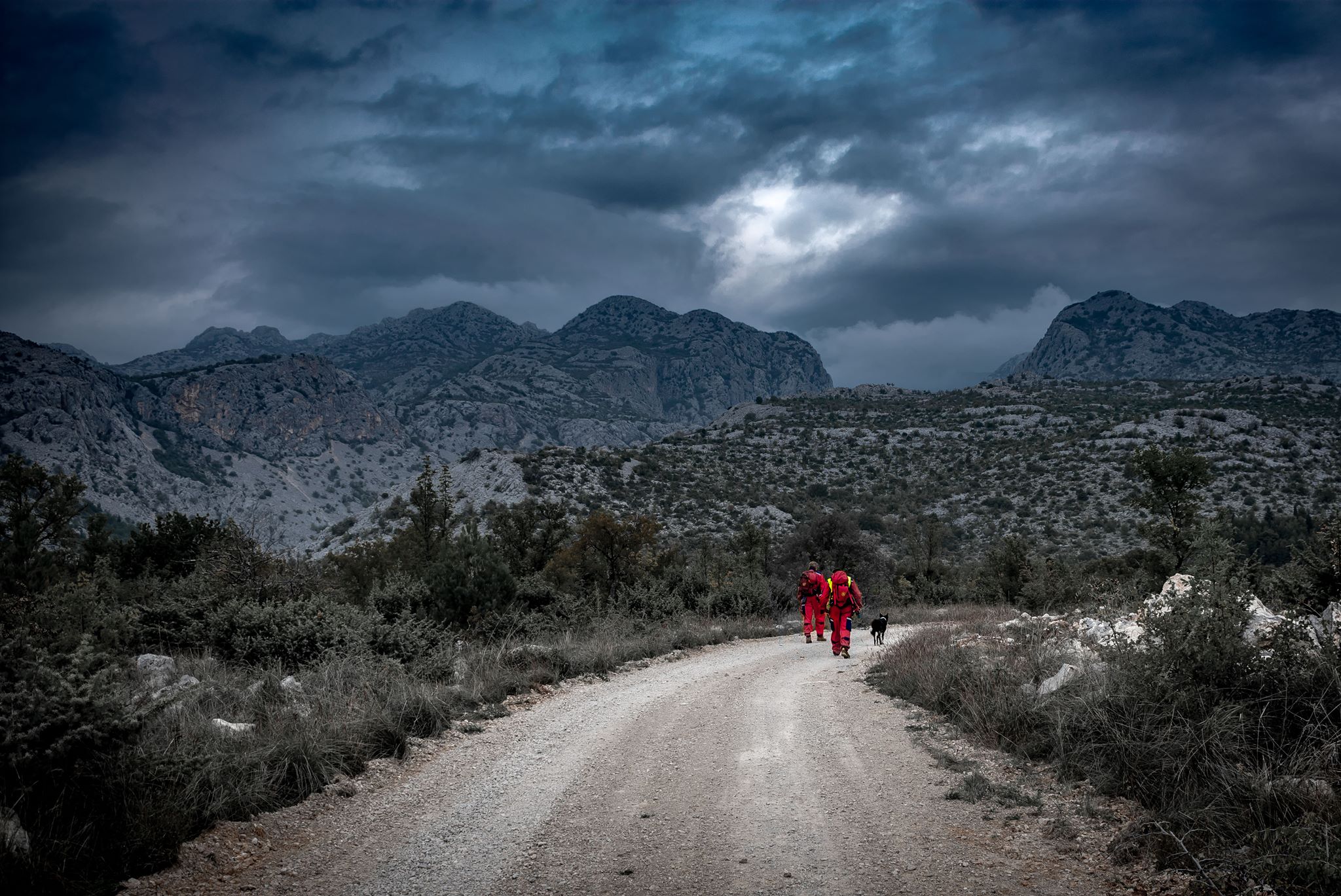
HGSS The Croatian Mountain Rescue Service members entering Paklenica under foreboding skies © HGSS The Croatian Mountain Rescue Service
I've really been on so many expeditions with HGSS. My station are on duty in the season at National Park Paklenica and I'm now the coordinator. Climbers from all around the world come and so there are many interventions. None of them are easy because the terrain is incredibly difficult. You really have to be in shape and know the techniques inside out.
I'm very proud of my statistics. Everyone I've rescued, who was alive when I reached them, is still living today. Unfortunately, not everyone we reach is alive when we arrive.
I remember one time, my husband and I were having dinner. We were arguing about the techniques and knots for moving a stretcher down a vertical climb. The training is so intense, you really have to know it well, and I guess that's just the kind of people that we are, that we would be arguing about it in our free time. Ha! He told me, "Why do you care? You'll never have to do that," because usually, it's really strong guys who do that specific job. If you're on a 400-metre-high section of rock, it really takes a lot of muscle.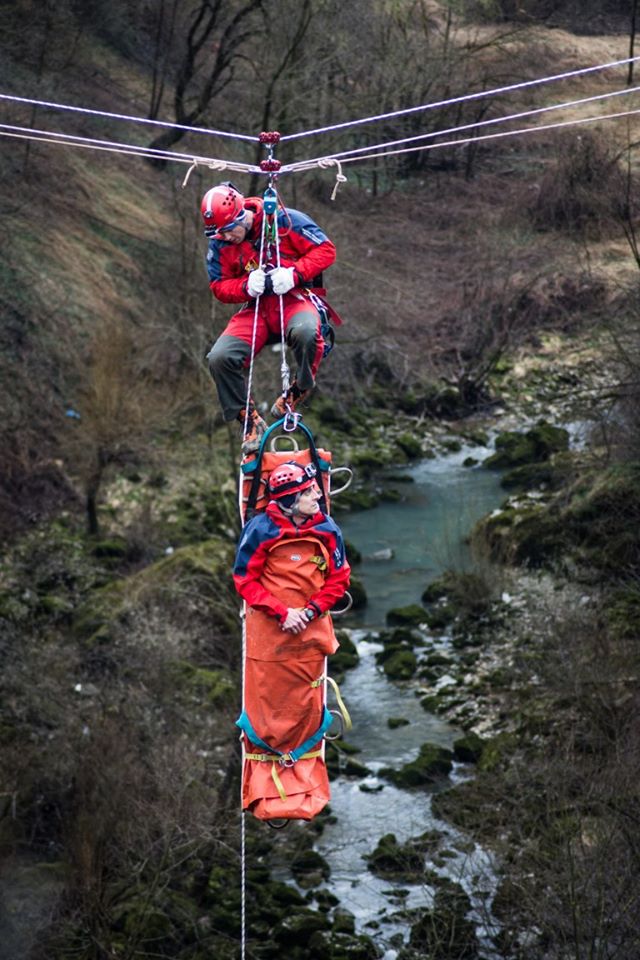
Ascending from a valley floor or descending from a mountain peak with a stretcher is a technically difficult operation, often hindered by darkness and adverse weather conditions. It requires a lot of training and a lot of muscle © HGSS The Croatian Mountain Rescue Service
In the evening, just two days later, we were called out to rescue an Italian guy who broke his leg on Anića Kuk. It's a really mighty part of the stone. And the leader of the expedition asked me to go on the stretcher. They pull you down on the ropes and you have to push very hard to keep the stretcher, the person you're carrying and yourself away from the rock, while balancing the weight of all three. It was dark, raining and with lots of Bura, the incredibly strong wind that sometimes hits us. That's probably my most memorable rescue.
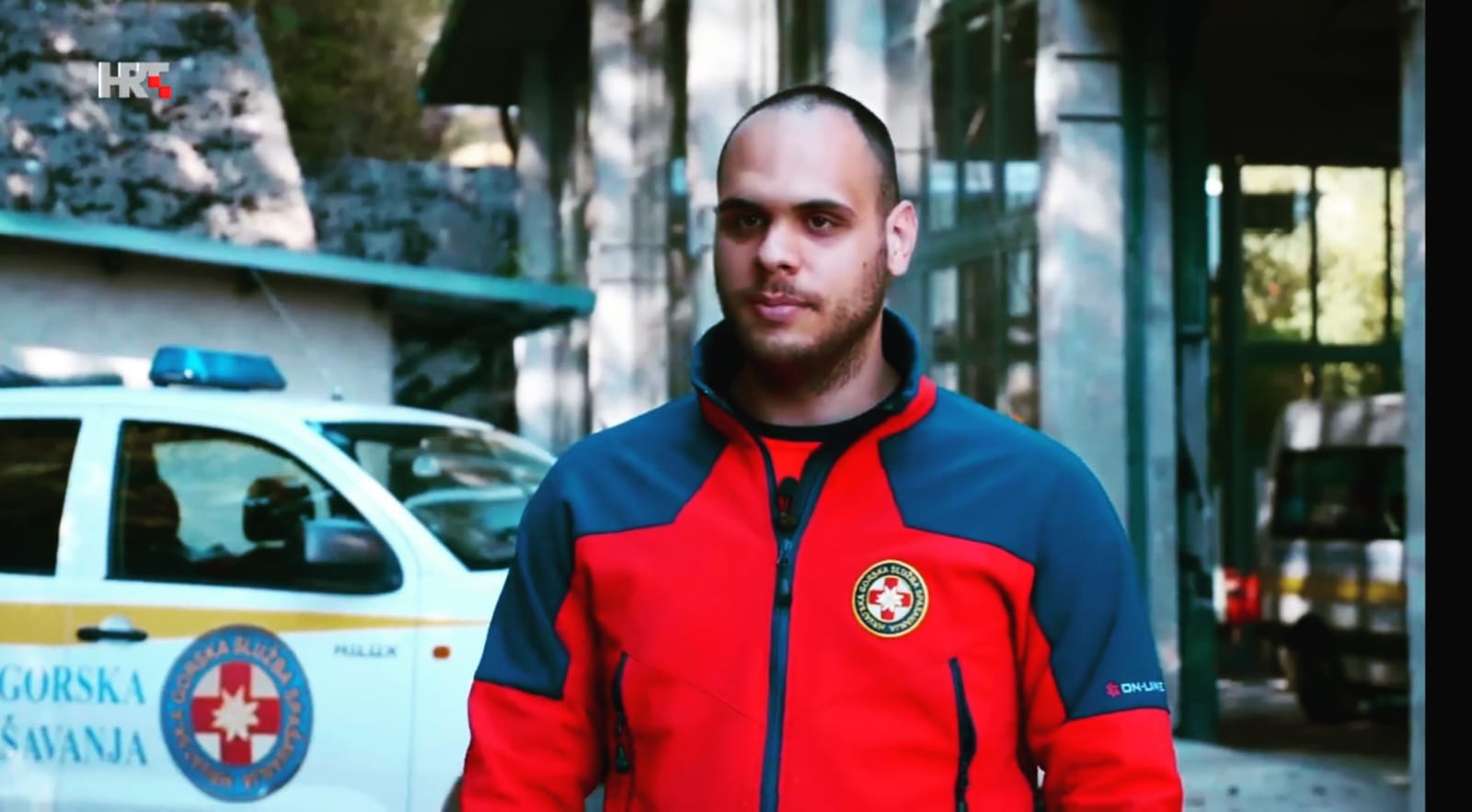
Petar Prpić, firefighter and volunteer for HGSS The Croatian Mountain Rescue Service
My name is Petar Prpić, I'm 25 years old and I'm from Hrvatska Kostajnica, just on the Croatian-Bosnian border. My station is in Novska. In my full-time job I'm a professional firefighter. I guess I have two dangerous jobs. Well, one job and one hobby.
I've always been interested in the outdoors – mountaineering, hiking, canoeing. But, that's not why I joined HGSS The Croatian Mountain Rescue Service. I just wanted to help people. I don't know, I guess it's just something in me.
We have a lot of rivers in our area. During the times of flood, we get a lot of call-outs. Our part of the country has a high percentage of elderly people in the population. A lot of them live in small villages, on the edge of the forest. We get a lot of call-outs for searches. Especially in the autumn when people go out looking for chestnuts or mushrooms. But, like all the stations in Croatia, we are here year-round if there are any actions in other parts of the country that need us.
In some areas, HGSS The Croatian Mountain Rescue Service are frequently called out in response to flooding. This picture shows HGSS members on operation during the 2014 floods. In that year, flooding across the whole region was so bad that HGSS members operated not only in Croatia, but also donated their services to neighbouring Bosnia and Serbia © HGSS The Croatian Mountain Rescue Service
I was just on the search in Biokovo. The head of service called me and asked me to go. I first had to get some free days from my job. I called my boss, Zvonimir Ljubičić, chief of the fire department. He's great, very understanding, and he gave me permission. Two years ago I was called to Rab. Very hard operation, very difficult terrain.
Late last summer, we were called out to look for an older man near Glina. It was around 11 o'clock in the evening. He'd gone to look for mushrooms in the afternoon and never came back. Police were there and they sent for us.
The man had a cell phone on him, but there was no signal. There was no location given off the phone. We were a team of four, split into two teams. We went up into the woods above Glina and concentrated our search on areas where we could see there was no telephone signal on our phones. We were yelling in the dark. After an hour of search, someone answered. He'd been missing since 2pm. We found him at 2am. He was just lying there, uninjured but unwell, unable to move.
The reason it sticks in my mind is that the next day, in the morning, his daughter called me. She was so thankful, so emotional. For sure we saved his life. None of the other emergency services who were present could find him. It was down to us. We finished the operation at about 6am and then all four of us had to go immediately to our regular jobs.
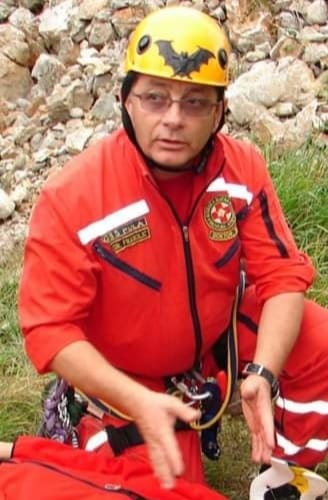
Mario Franolić, physician, ex-commando and volunteer for HGSS The Croatian Mountain Rescue Service
My name is Mario Franolić and I'm 60 years old. I'm the chief of the mountain rescue service in Istria. I travel throughout Croatia because I'm also an instructor for the medical commission of HGSS. I was born on island Krk. I'm based in Pula although I work in Rijeka. I travel a lot between the two. I've been with HGSS The Croatian Mountain Rescue Service for 18 years.
In my day job, I'm a physician. I am a senior mentor at the Institute for Underwater and Hyperbaric Medecine in the Clinical Hospital Rijeka. I'm an expert in my field of emergency medecine. I've been doing it for almost 30 years.
When I was young, I trained to be a physician in Belgrade. It was then the best medical faculty in Yugoslavia. At the same time, I also started spelunking (cave exploration). I've been doing it since 1978. Later, I was a physician in the military underwater commando unit. I lived in Austria for five years, but when I came to Pula, they were just starting the HGSS The Croatian Mountain Rescue Service station here. They asked me for help because they didn't have any medical professional on the team. I accepted. It would be a waste not to use all these skills I have.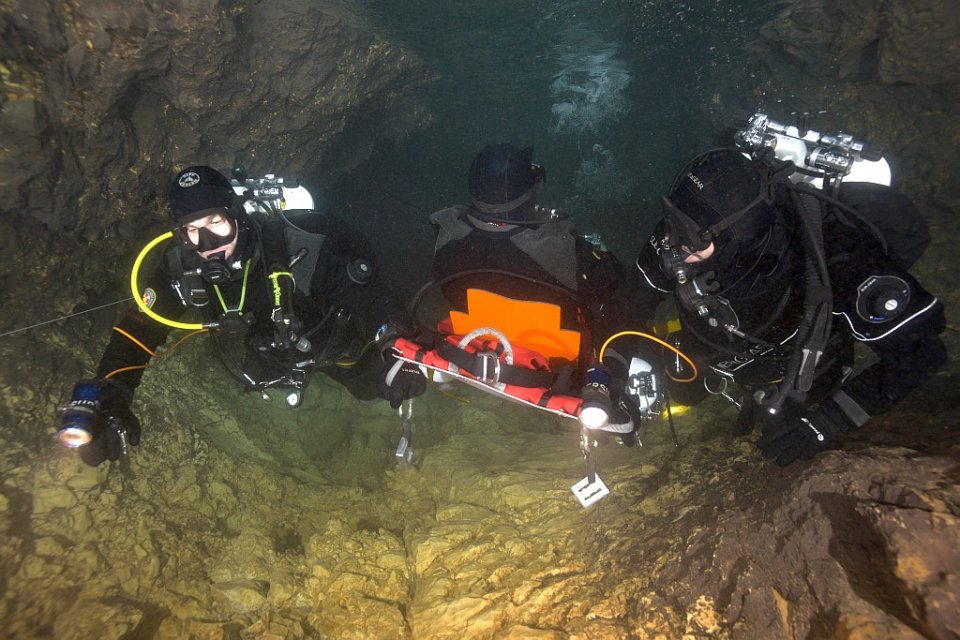
Specialist teams from HGSS are trained in underwater rescue from caves. Such caves exist all over Croatia in the karst rock, and also on some islands © HGSS The Croatian Mountain Rescue Service
Sometimes, our status as volunteers can give us problems. Although we have official duties, we are more like an NGO than something like the police. There can be legal implications. I remember one situation, very acute because a paraglider fell from the sky. None of his colleagues saw him fall. Paragliders go into the air together, but then they each branch off to do their own thing.
We had no idea about the location. We started from the last point of sighting, knowing that it could be very far from the place where he actually fell. But, we had to start somewhere. We had one mobile phone signal direction. But, you need three in order to locate someone. We only had a line on the map.
In the past, HGSS The Croatian Mountain Rescue Service sometimes had difficulties because the telephone companies wouldn't give us the information we needed in order to triangulate the position of a missing person. They would only give it to the police. But, it's a race against time. We searched for this man all day and all night. In the morning, some Croatian paragliders made private contact with a guy from the phone company. They begged him to release the information we needed. Although he could lose his job, giving such information to private citizens, he did it.
We found the man about 150 metres from where we were. Sadly, he was already dead. It was very small comfort to see that he had died instantly, on impact. It's unbearable when you reach someone you could have saved if only you had got there quicker, especially in an instance such as this, where we were hindered by a lack of information that was available. I think it moves more quickly now, but still we have to go through the police.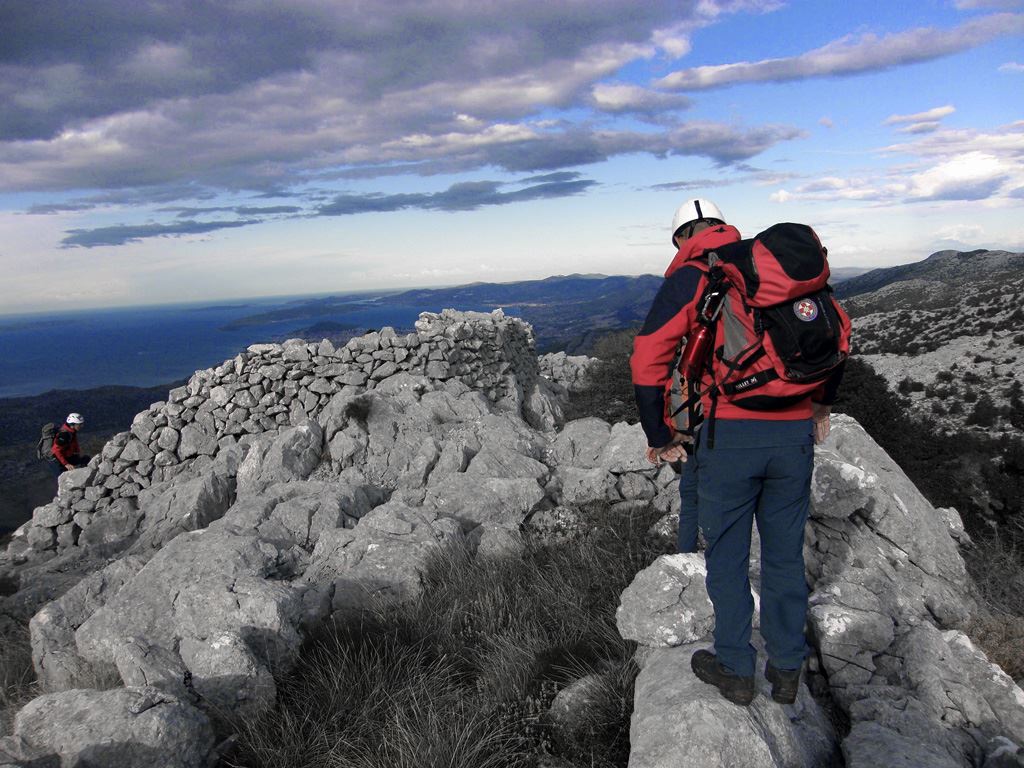
© HGSS The Croatian Mountain Rescue Service
One of the most emotional operations I went on was around five years ago, the rescue of a young girl - maybe two and a half to three years old – who got lost in the woods in a small place in central Istria. She chased into the forest after some dogs around 10 or 11 in the morning. The family saw immediately that she had disappeared and started to search. About two hours later, we were called out. It was impossible for the family to find her.
About 300 people came – my station, the Rijeka station, hunters, firemen, police and volunteers. In such an operation, the police are the lead service. But, 99% of the time they leave the organisation of the search to HGSS The Croatian Mountain Rescue Service. We are the only organisation who is very well educated in organising searches. When other people do searches, they use intuition. But, people all have different intuition. It can be chaotic. We are highly trained for this. There are procedures, recognised internationally, that we follow. We found her early in the morning, at around 7 o'clock. The dogs were lying on each side of her, giving her warmth.
All photos courtesy volunteers and HGSS The Croatian Mountain Rescue Service
Huge Interest in Biokovo Skywalk, Online Tickets to be Introduced Next Year
August 12, 2020 - Since the Biokovo Skywalk opening, Biokovo has become one of the most sought after locations overnight, not only on the Makarska coast but far beyond.
Slobodna Dalmacija reports that this heavenly lookout has ushered Biokovo into the new age tourism industry, where there is no time for an in-depth exploration of the destination; most tourists want to put a "check" on their "must visit" list and capture the experience with a camera.
But is Biokovo ready for this rush of hungry tourists? And, quite frankly, what comes next?
Slavo Jaksa, director of the Public Institution Biokovo Nature Park, comments on the future of Dalmatia's hit attraction.
"The Skywalk is in itself an attraction and an additional product of the nature park that has raised the level of attractiveness of the whole of Biokovo. How much interest has increased, it is difficult to say for now because the year is as it is, and it is not a year to make comparisons," he points out.
"We expected an increase in the number of visitors and increased interest, but I must admit that we were still surprised by the extent of it," adds Jaksa.
The current problem is the crowds on Biokovo, which are created due to the enormous interest, and in the current year, this issue is being solved by limiting the number of vehicles. Namely, only 25 vehicles can enter in an hour, but it happens that tourists return because the queues are too big, or because the closing time of the park is approaching. Thus, long lines are standard.
"It is not so much of a burden because we control it. Namely, we also regulate the issue of road congestion and possible pollution," claims Jaksa, adding that next year they plan to sell tickets online.
"This will reduce congestion and the influx of cars. It would function like at Plitvice Lakes or Krka, and tourists would come at a certain time when they take a ticket and thus significantly reduce the crowds," the director adds.
Is Biokovo endangered in the sense that it is now suddenly visited by a mass of tourists?
"Not yet. We as an institution are here to protect the mountain, and we ensure the protection of nature and monitor, and when this season is over, we will evaluate and see what can be concluded and applied next year. But I always say that Biokovo protects itself only for the simple reason that it is an inaccessible mountain. We do not yet know whether this is just an opening effect or will be a continuous public interest. We will see where improvements are needed and prepare for the next year in which, we hope, tourism will return as it was, which we all want," explains Jaksa.
For the next year, other facilities are planned, along with the already completed lookout point and a new bicycle and hiking trail, visitor center, and children's playground. The project is worth 34 million kuna.
"All this will be completed in 2021 and it is clear that the structure of guests is now changing. We get a wider base, and with Biokovo Skywalk, we see what effect has been achieved, not only for tourism on the Makarska coast, but for the county and Croatia. We have tourists who come from other counties, while so far Biokovo has been visited mainly by guests from the Makarska Riviera," says Jaksa.
The more extensive base also means the need to educate visitors, which the director says they are already doing at the reception itself.
So, what can we expect next year? How will the road handle increasing traffic?
Jaksa emphasizes that they will be significantly relieved by selling tickets online, and as far as the road itself is concerned, he agrees that it is too narrow. Thus, Jaksa warns to drive at your own risk.
In principle, there are plans to rebuild the road, but for now, it is a long shot. There was also talk of shuttle buses, which are actually the best, safest and most environmentally friendly solution, though this was also left for the second budget period. Recall, a public transport system was discussed within the existing project "New Adrion - Promoting the sustainable use of the natural heritage of PP Biokovo".
For the latest travel info, bookmark our main travel info article, which is updated daily.
Read the Croatian Travel Update in your language - now available in 24 languages
Join the Total Croatia Travel INFO Viber community.
VIDEO: Biokovo Skywalk Ahead of 2020 Summer Opening
June 4, 2020 - Biokovo Nature Park will soon be enhanced thanks to the most attractive lookout point in Croatia - the new Biokovo Skywalk.
Namely, Dalmacija Danas reports that the construction of the Biokovo Skywalk began last year in the Ravna Vlaška area. Although the end of the works was announced for the spring, the coronavirus crisis has taken its toll, and it's not surprising that the highly anticipated opening is delayed. Although it has already garnered a great deal of public attention, the Skywalk is still not open to the public and walking on it is strictly forbidden.
Unofficially, Dalmacija Danas learns that the project will be completed by the end of June, and the permit for use should be obtained within 60 days from the end of the works.
On Wednesday, Split photographer Eddy Meštrović visited Ravna Vlaška and filmed the new Skywalk from above.
The glass walk over the abyss will be a great attraction that will bring even more visitors to this Nature Park. The construction of the glass lookout is part of a project called 'New Adrion - Promoting the Sustainable Use of the Natural Heritage of PP Biokovo'.
The Skywalk is located 1228 meters above sea level and is envisaged as an upgrade of an existing lookout point in the Ravna Vlaška area of the Biokovo Nature Park.
This lookout is designed as a prestressed reinforced concrete structure that cantilevers over a cliff overlooking the Makarska Riviera, Adriatic, islands, and open sea. A glass walkway has been laid on the primary concrete structure to provide a bird's eye view in all directions, creating a unique adrenaline experience.
The potential of the Ravna Vlaška lookout point has been enhanced by an innovative architectural and engineering solution, which with its attractiveness, goes beyond the local tourist offer and contributes to the tourist potential of the whole of Dalmatia.
Within this part of the Biokovo Skywalk project, which will be in the zone of the visitor infrastructure of Ravna Vlaška, the construction of a geological pillar with special infoblocks is envisaged. It is a three-dimensional representation of the cross-section of geological periods and the geological origin of Dalmatia's glorious Biokovo Nature Park, which will be made according to the inputs of the park's expert service.
The total cost of the construction of the lookout and the geological pillar, as well as its accompanying surveillance, stands at slightly more than 8 million kuna in total.
To read more about lifestyle in Croatia, follow TCN's dedicated page.


